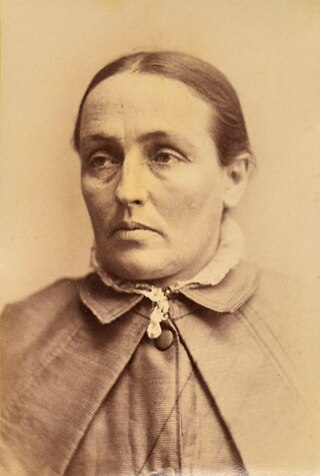Related Research Articles
The Chicago Tylenol murders were a series of poisoning deaths resulting from drug tampering in the Chicago metropolitan area in 1982. The victims consumed Tylenol-branded acetaminophen capsules that had been laced with potassium cyanide. Seven people died in the original poisonings, and there were several more deaths in subsequent copycat crimes.

Richard Leonard Kuklinski, also known as the Iceman, was an American criminal and a convicted murderer. He was engaged in criminal activities for most of his adult life; he ran a burglary ring and distributed pirated pornography. Kuklinski committed at least five murders between 1980 and 1984. Prosecutors described him as killing for profit. He was nicknamed the "Iceman" by authorities after they discovered that he had frozen the body of one of his victims in an attempt to disguise the time of death.
These are lists of poisonings, deliberate and accidental, in chronological order by the date of death of the victim(s). They include mass poisonings, confirmed attempted poisonings, suicides, fictional poisonings and people who are known or suspected to have killed multiple people.

Ronald Clark O'Bryan, nicknamed The Candy Man and The Man Who Killed Halloween, was an American man convicted of killing his eight-year-old son Timothy on Halloween 1974 with a potassium cyanide-laced Pixy Stix that was ostensibly collected during a trick or treat outing. O'Bryan poisoned his son in order to claim life insurance money to ease his own financial troubles, as he was $100,000 in debt. O'Bryan also distributed poisoned candy to his daughter and three other children in an attempt to cover up his crime; however, neither his daughter nor the other children ate the poisoned candy. He was convicted of capital murder in June 1975 and sentenced to death. He was executed by lethal injection in March 1984.

Anna Marie Hahn was a German-born American serial killer. She murdered 5 elderly men from Cincinnati by poison between 1933 and 1937. She was convicted of murder and executed by electric chair in 1938.
Stella Maudine Nickell is an American woman who was sentenced to ninety years in prison for product tampering after she poisoned Excedrin capsules with lethal cyanide, resulting in the deaths of her husband Bruce Nickell and Sue Snow, a stranger. Her May 1988 conviction and prison sentence were the first under federal product tampering laws instituted after the 1982 Chicago Tylenol murders.
Autopsy is a television series of HBO's America Undercover documentary series. Dr. Michael Baden, a real-life forensic pathologist, is the primary analyst, and has been personally involved in many of the cases that are reviewed.

Julia Lynn Turner was an American woman who was convicted in the poisoning deaths of her two husbands.
This is a list of notable overturned convictions in the United States.

Cyanide poisoning is poisoning that results from exposure to any of a number of forms of cyanide. Early symptoms include headache, dizziness, fast heart rate, shortness of breath, and vomiting. This phase may then be followed by seizures, slow heart rate, low blood pressure, loss of consciousness, and cardiac arrest. Onset of symptoms usually occurs within a few minutes. Some survivors have long-term neurological problems.
This is a list of notable overturned convictions in Canada.

James Joseph Richardson was an African-American man who was wrongfully convicted and sentenced to death in 1968 for the October 1967 mass murder of his seven children. They died after eating a poisoned breakfast containing the organic phosphate pesticide parathion. At the time of the murders, Richardson was a migrant farm worker in Arcadia, Florida living with his wife Annie Mae Richardson and their children. At a trial in Fort Myers, Florida, the jury found him guilty of murdering the children and sentenced him to death. As a result of the United States Supreme Court's 1972 Furman v. Georgia decision finding the death penalty unconstitutional, his sentence was commuted to life imprisonment. He was then exonerated in 1989 after 21 years, when his case was revisited by appointed Miami-Dade County prosecutor Janet Reno. Following Richardson's exoneration, the babysitter of the Richardson children, Bessie Reece, has been named as the key suspect. Reece died in 1993. In 2016 he began receiving compensation under a state law narrowly tailored to his case.

Louisa Collins 11 August 1847 – 8 January 1889) was an Australian convicted murderer. She lived in the Sydney suburb of Botany and married twice, with both husbands dying of arsenic poisoning under suspicious circumstances. Collins was tried for murder on four separate occasions, with the first three juries failing to reach a verdict. At the fourth trial the jury delivered a guilty verdict for the murder of her second husband and she was sentenced to death. Louisa Collins was hanged at Darlinghurst Gaol on the morning of 8 January 1889. She was the first woman hanged in Sydney and the last woman to be executed in New South Wales.
The death of Joan Robinson Hill at 38 years old led to her husband, John Hill, becoming the first person to be indicted by the State of Texas on the charge of murder by omission. The case precipitated a series of events that included the 1972 murder of John Hill and, two years later, the fatal police shooting of the man accused of that murder.
Hannah Hanson Kinney was an American seamstress who was charged with the murder of her third husband, George Kinney in 1840. Arsenic, the alleged murder weapon, was found in Kinney's stomach during an autopsy. Though Kinney was acquitted, public records indicate that Kinney's second husband, Reverend Enoch W. Freeman, and Freeman's father, died of arsenic poisoning years earlier. Public consensus following Kinney's trial deemed her guilty, and she published an autobiography in 1841 to defend herself.

Steven David Catlin is a convicted American serial killer who murdered two wives and his adoptive mother in California and Nevada from 1976 until 1984. Sentenced to death in 1990, he is currently housed in San Quentin State Prison.
On 6 January 2016, Wayan Mirna Salihin died in Abdi Waluyo Hospital after drinking a Vietnamese iced coffee at the Olivier Cafe in the Grand Indonesia shopping mall in Jakarta. According to the police, cyanide poisoning was most likely the cause of Mirna's death. Police charged Jessica Kumala Wongso with her murder. Jessica was found guilty of the murder and was sentenced to 20 years. Jessica's appeal was later rejected by the higher court.
Columbus Lee Harkins (1864 – July 30, 1920) was an American veterinary surgeon, serial child rapist, and suspected mass murderer.
David Albert Dowler is an American serial killer who poisoned three acquaintances in Odessa, Texas with chloroform and cyanide between 1983 and 1987. Convicted of a single murder, he was sentenced to life imprisonment in 1988.
On February 17, 1933, William J. Costello, a fire captain in Peabody, Massachusetts, was found dead by his wife, Jessie B. Costello. After an autopsy found a lethal amount of potassium cyanide in his body, Jessie was charged with his murder. At trial, her defense team contended that her husband had killed himself or had ingested the poison accidentally. She was acquitted after a highly publicized trial.
References
- ↑ "Lethal Vows". IMDb . Retrieved 2023-03-31.
Based on the true story of Richard K. Overton, convicted of poisoning his ex-wife Dorothy Boyer, and the murder of his third wife, Janet Overton.
- ↑ Flaherty, Mike (October 15, 1999). "What to Watch". Entertainment Weekly . Archived from the original on June 1, 2007. Retrieved 2009-07-10.
- 1 2 3 4 5 Ellingwood, Ken (1995-09-02). "Life Sentence for Overton in Wife's Murder : Courts: The Dana Point man still claims he's innocent of her 1988 cyanide poisoning. He faces no chance of parole because the school board trustee's slaying involved a special circumstance". Los Angeles Times .
- 1 2 Ellingwood, Ken; Lait, Matt (1995-05-09). "Overton Found Guilty of Wife's Cyanide Murder". Los Angeles Times .
The bizarre case centered heavily on diary entries by Richard K. Overton that revealed the couple's mutual hatred and the defendant's bitter suspicion that his wife had numerous sexual affairs. A first trial ended in a mistrial in 1992, when Overton's former defense attorney suffered a severe depression and could not continue. ... Authorities said Overton had access to cyanide because he was part-owner in a mining operation.
- ↑ Lait, Matt (1992-06-17). "Overton's Ex-Wife Testifies of Poisoning : Trial: She alleges that news of Janet Overton's death prompted her to say she was target of plot too". Los Angeles Times .
Boyer, the prosecution's star witness, told the jury in a steady voice that the 64-year-old defendant began surreptitiously spiking her beverages with poison shortly after the breakup of their marriage in 1969. They had been married 17 years and had raised four children, she said. The marriage ended, Boyer said, after she discovered that Overton, using a co-worker's name, had married another woman and fathered a child. ... According to a written report by Miller, which has not yet been introduced as evidence in the trial, Overton confessed to putting Drano and prescription drugs in Boyer's coffee and shampoo. Boyer told jurors that she decided not to press charges against Overton because Miller had told her that her ex-husband agreed never to do it again and to seek counseling.
- 1 2 Lin II, Rong-Gong (2009-06-07). "Richard K. Overton dies at 81; convicted of fatally poisoning his wife". Los Angeles Times .
Richard K. Overton, the subject of one of Orange County's most riveting trials who was convicted of murdering his wife, a popular school board member, by slipping her poisons in 1988, has died, the California Department of Corrections and Rehabilitation has confirmed. He was 81.
- ↑ Dziemianowicz, Joe (2021-12-12). "Murder By Mascara: Jealous Husband Fatally Lashes Out At His Wife By Poisoning Her Makeup - Investigators uncovered a sinister scheme to poison Janet Overton, an Orange County mom". Oxygen (TV channel) .